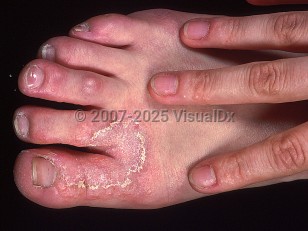Tinea pedis in Child
See also in: Cellulitis DDxAlerts and Notices
Important News & Links
Synopsis

Tinea pedis ("athlete's foot") is a localized superficial fungal infection. It is rare in childhood and occurs more commonly in adolescence and adulthood.
Trichophyton rubrum, Trichophyton interdigitale, Trichophyton mentagrophytes, and Epidermophyton floccosum are the most common dermatophytes responsible for most cases of tinea pedis. Nondermatophyte molds and candidal yeasts can less frequently cause tinea pedis.
Factors leading to this infection include high levels of humidity; occlusive footwear; use of communal pools, showers, or baths (including locker rooms); sharing clothing with infected individuals; and proximity to animals (including pets).
There are 3 main types of tinea pedis: interdigital (most common), hyperkeratotic / moccasin, and vesiculobullous tinea pedis.
In interdigital tinea pedis, the web spaces and soles are affected most frequently with erythema, scale, and maceration of web spaces. The condition may spread to involve the nonplantar surfaces of the foot as well. Interdigital maceration, especially of the lateral fourth and fifth toe webs, is commonly seen.
Hyperkeratotic / moccasin tinea pedis presents with hyperkeratotic plaques with erythema on the lateral and medial foot, dorsum, and soles of the feet in a "moccasin" shoe pattern. There is often a collarette of scale along the border of the foot.
Vesiculobullous tinea pedis is rare in children and presents with pruritic and painful vesicles and bullae overlying the erythematous lesions.
Tinea incognito may occur when the patient is misdiagnosed and treated with topical steroids, which reduces the scale and erythema of the lesions.
The infection may be pruritic or asymptomatic. It is often asymmetric, with only one foot being affected or more widespread on one foot than the other. In some cases, it can progress and cause concomitant onychomycosis (tinea unguium).
Interdigital cracking and maceration may act as a portal of entry for pathogens and may predispose to lymphangitis or cellulitis. A dermatophytid reaction (also called an "id reaction") is a hypersensitivity process that can occur secondary to tinea pedis. The condition manifests on the lateral aspects of the fingers and may mimic dyshidrotic dermatitis, and may also be seen on the trunk and other parts of the body. This hypersensitivity process will resolve with adequate treatment of the dermatophyte infection.
Immunocompromised patient considerations: In patients with HIV infection and other immunodeficient states, interdigital tinea pedis has been noted to spread to involve the dorsal foot in an extensive manner.
Trichophyton rubrum, Trichophyton interdigitale, Trichophyton mentagrophytes, and Epidermophyton floccosum are the most common dermatophytes responsible for most cases of tinea pedis. Nondermatophyte molds and candidal yeasts can less frequently cause tinea pedis.
Factors leading to this infection include high levels of humidity; occlusive footwear; use of communal pools, showers, or baths (including locker rooms); sharing clothing with infected individuals; and proximity to animals (including pets).
There are 3 main types of tinea pedis: interdigital (most common), hyperkeratotic / moccasin, and vesiculobullous tinea pedis.
In interdigital tinea pedis, the web spaces and soles are affected most frequently with erythema, scale, and maceration of web spaces. The condition may spread to involve the nonplantar surfaces of the foot as well. Interdigital maceration, especially of the lateral fourth and fifth toe webs, is commonly seen.
Hyperkeratotic / moccasin tinea pedis presents with hyperkeratotic plaques with erythema on the lateral and medial foot, dorsum, and soles of the feet in a "moccasin" shoe pattern. There is often a collarette of scale along the border of the foot.
Vesiculobullous tinea pedis is rare in children and presents with pruritic and painful vesicles and bullae overlying the erythematous lesions.
Tinea incognito may occur when the patient is misdiagnosed and treated with topical steroids, which reduces the scale and erythema of the lesions.
The infection may be pruritic or asymptomatic. It is often asymmetric, with only one foot being affected or more widespread on one foot than the other. In some cases, it can progress and cause concomitant onychomycosis (tinea unguium).
Interdigital cracking and maceration may act as a portal of entry for pathogens and may predispose to lymphangitis or cellulitis. A dermatophytid reaction (also called an "id reaction") is a hypersensitivity process that can occur secondary to tinea pedis. The condition manifests on the lateral aspects of the fingers and may mimic dyshidrotic dermatitis, and may also be seen on the trunk and other parts of the body. This hypersensitivity process will resolve with adequate treatment of the dermatophyte infection.
Immunocompromised patient considerations: In patients with HIV infection and other immunodeficient states, interdigital tinea pedis has been noted to spread to involve the dorsal foot in an extensive manner.
Codes
ICD10CM:
B35.3 – Tinea pedis
SNOMEDCT:
6020002 – Tinea pedis
B35.3 – Tinea pedis
SNOMEDCT:
6020002 – Tinea pedis
Look For
Subscription Required
Diagnostic Pearls
Subscription Required
Differential Diagnosis & Pitfalls

To perform a comparison, select diagnoses from the classic differential
Subscription Required
Best Tests
Subscription Required
Management Pearls
Subscription Required
Therapy
Subscription Required
References
Subscription Required
Last Reviewed:03/24/2025
Last Updated:03/27/2025
Last Updated:03/27/2025
 Patient Information for Tinea pedis in Child
Patient Information for Tinea pedis in Child
Premium Feature
VisualDx Patient Handouts
Available in the Elite package
- Improve treatment compliance
- Reduce after-hours questions
- Increase patient engagement and satisfaction
- Written in clear, easy-to-understand language. No confusing jargon.
- Available in English and Spanish
- Print out or email directly to your patient
Upgrade Today

Tinea pedis in Child
See also in: Cellulitis DDx
